Green Tech Statistics By Market Size and Facts (2025)
Updated · Sep 18, 2025
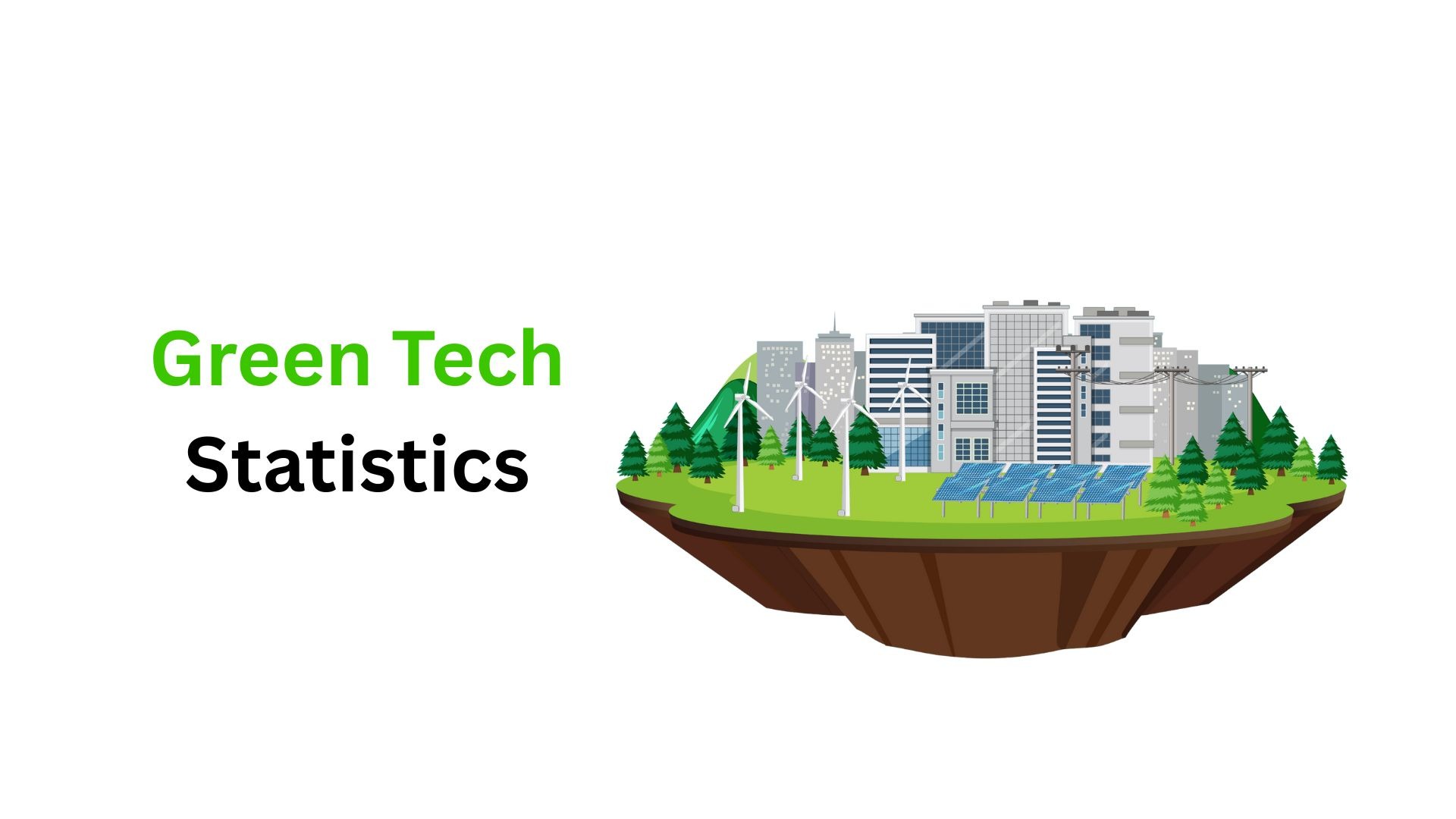
Table of Contents
- Introduction
- Editor’s Choice
- Green Tech Market Size
- Leading Countries Prepared For The Green Tech Transition
- Public And Private Investment In Green Tech In The U.S
- Top Export Of Green Tech From Developed/Developing Nations
- Top Industry Investing In Green Tech Sector
- Green Tech Trends
- UK’s Green Technology Landscape
- Recent Developments
- Conclusion
Introduction
Green Tech Statistics: Green technology, or greens, strives to prevent environmental or social harm through cutting-edge science applications. It involves sustainable products, services, and practices to conserve resources, reduce greenhouse gas emissions, switch to renewable energy, and counter the harsher side effects of global warming for a cleaner and sustainable environment.
In 2024-25, green technology kept growing fast with solar panels, wind turbines, electric vehicles, batteries, clean hydrogen, and energy-efficient buildings. Here’s a consolidation of top Green Tech Statistics for 2025, showing just how much the green transition is shaped at the moment.
Editor’s Choice
- The global green tech and sustainability sector mentions 1,611 startups and more than 3,100 companies, growing at 8.90% last year.
- At a CAGR of 22.94%, the market shall touch the USD 185.21 billion mark in 2034.
- North America led the market in 2024 with a 38.68% share, while Europe is expected to grow fast.
- According to UNCTAD, the U.S., Sweden, Singapore, Switzerland, and the Netherlands are the most prepared countries in terms of frontier technologies, whereas Guinea, DRC, Gambia, Guinea-Bissau, and South Sudan are the least.
- With a workforce of around 231,900 people spread over 1,846 firms, green hydrogen has grown annually by 32.57%.
- Green biotechnology employs only 1,500 people in a mere 68 companies, growing annually at 25.9%.
- Green roof technology employs 870 across 31 companies with an annual growth of a mere 2.68%.
- UK startups raised £4.5 billion in 2024, with climate tech accounting for 29% of all VC activities.
- The UK has reduced greenhouse gas emissions by 53% since 1990 and has almost completely phased out coal.
- FAO has launched AIM4Commodities, a US$1.4 million initiative to strengthen data for forest agrifood systems and promote sustainability.
Green Tech Market Size
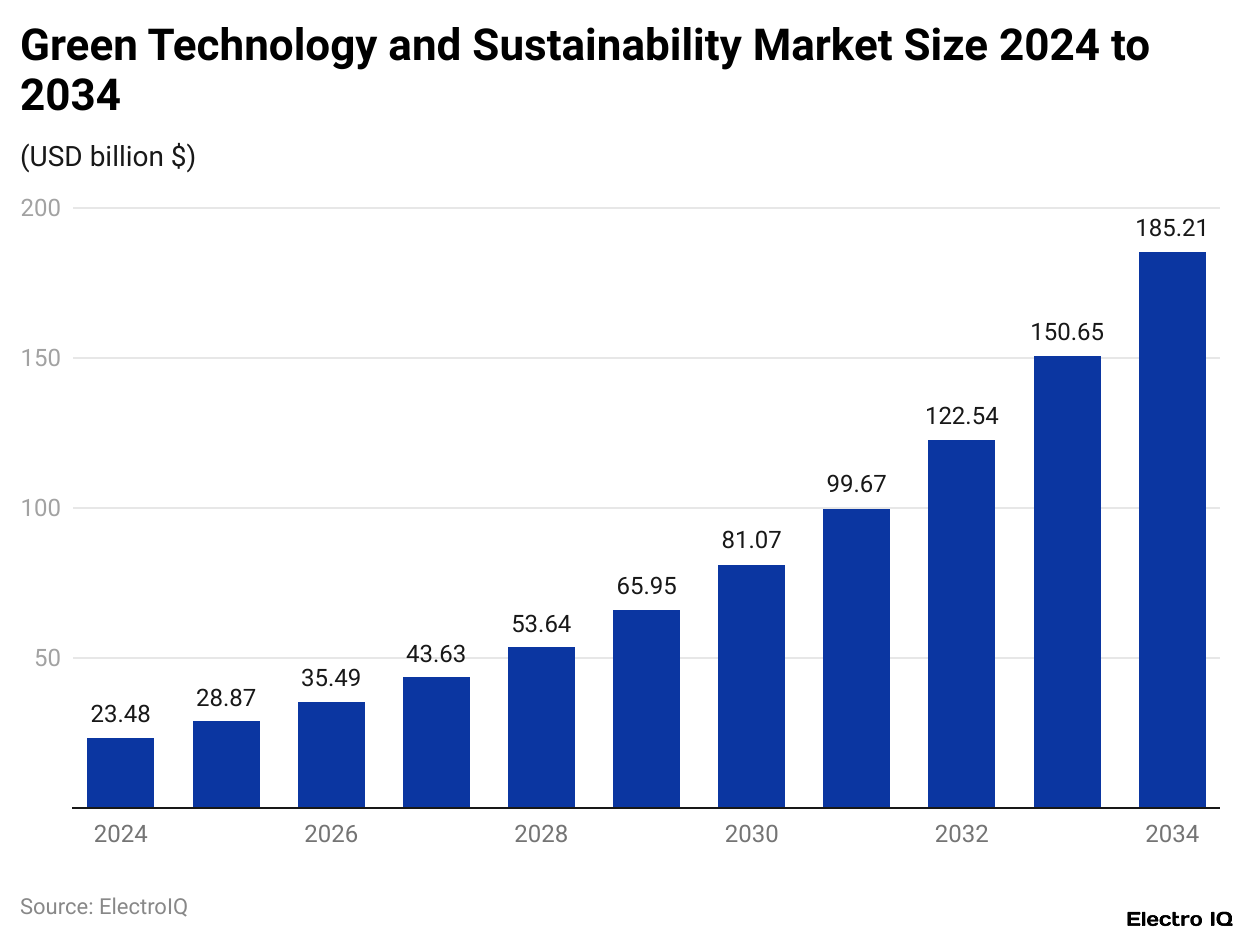
(Reference: startus-insights.com)
- As per Startus Insights, Green Tech Statistics data showcases the scale and growth of the green technology and sustainability segment.
- It touches upon 1,611 startups and more than 3,100 companies, giving an account of the active participation in this industry.
- Growth recorded was 8.90% last year, pointing to a steady pace of development.
- Both innovation and funding are strong, with over 2,700 patents and 470-plus grants recorded.
- On a global level, according to the World Intellectual Property Organisation, 31.4% of active patent families are linked to the United Nations Sustainable Development Goals.
- According to the forward-looking forecast, the market size will rise to USD 185.21 billion by 2034, at a CAGR of 22.94% during the period from 2025 to 2034.
- Ruling with a 38.68% share in 2024, North America takes the crown, whereas the European countries have been reputable for the rapid growth expected to transpire in the years to come.
- The solutions were holding the dominant side of the components in 2024, although services are expected to witness the fastest growth in the forecast period.
- By industry, green buildings had the largest share in 2024.
Leading Countries Prepared For The Green Tech Transition
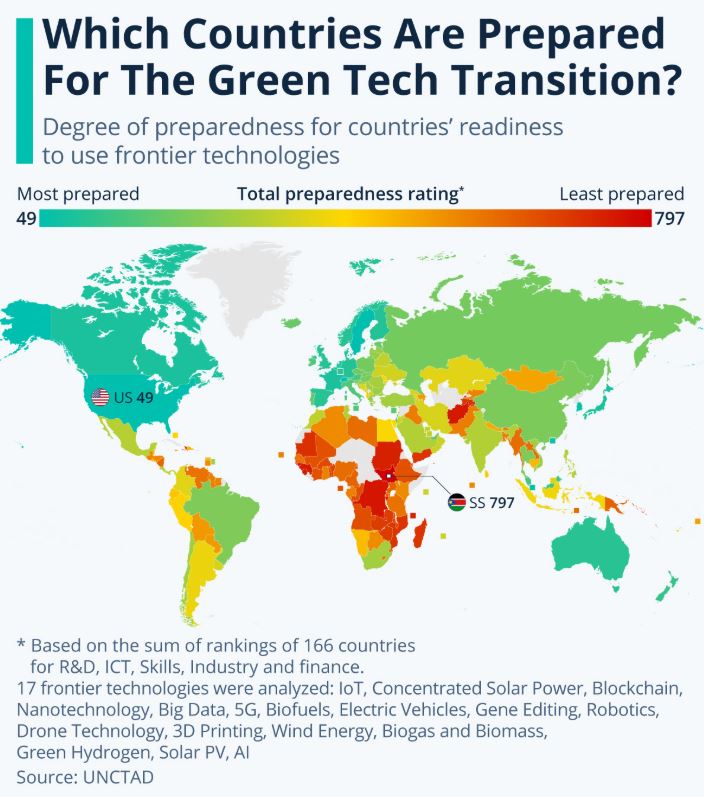
(Source: statista.com)
- The United Nations Trade and Development Council (UNCTAD) ranked 166 countries according to how prepared they are to adopt frontier technologies deeply relevant for the green-tech transition.
- The ranking was based on five indicators: ICT, skills, industry, R&D, and finance. Accordingly, a final score was allocated to each country by adding up the ranks of each of these indicators.
- Countries with the highest scores were the United States, Sweden, Singapore, Switzerland, and the Netherlands; essentially, they were the most ready to utilise or adapt to frontier technologies.
- At the opposite end of the spectrum, very poorly, Guinea, the Democratic Republic of Congo, Gambia, Guinea-Bissau, and South Sudan were the least prepared.
- The findings highlight a clear divide between high-income and lower-income nations, with regions such as Latin America, the Caribbean, and sub-Saharan Africa being the least ready to take advantage of these technologies and thus potentially being deprived of new avenues.
- China, despite being top in the world in developing and innovating frontier technologies, lagged far behind in 35th place.
- This was mainly due to differences in internet coverage and broadband speeds across urban and rural areas.
- Other BRICS members also tend to have very low rankings, ranking Brazil 40th, India 46th, and South Africa 56th.
- However, some Asian countries did better than expected. Vietnam came 45th, the Philippines 57th, and India ranked 55th in one segment of the assessment.
- Compared to rankings calculated based on per capita income, India did very well, coming in 67 places higher than expected.
- According to UNCTAD, the good showing was attributed to investments in infrastructure, stronger technical skills, and a business environment conducive to growth.
Public And Private Investment In Green Tech In The U.S
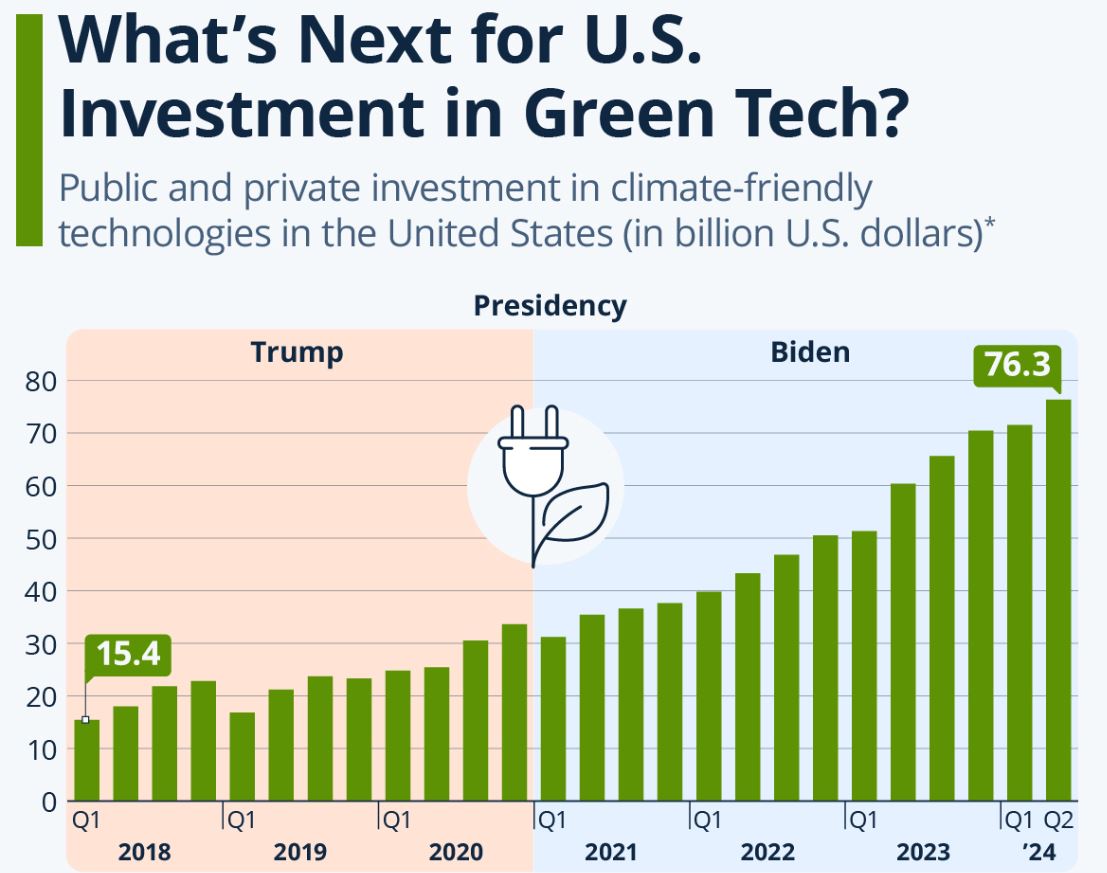
(Source: statista.com)
- According to UNCTAD, the U.S., Sweden, Singapore, Switzerland, and the Netherlands prevail as the best frontier-technology-adapting nations.
- These technologies themselves will generously intervene in the green technology transition. UNCTAD looked at 166 countries with five indicators: ICT, skills, industry, R&D, and finance.
- The rankings on each indicator were added to form a consolidated score. For instance, the U.S. ranked 2nd for R&D, 11th for ICT, 18th for skills, 16th for industry, and 2nd for finance, making its total 49.
- Moving to the other extreme, Guinea, the Democratic Republic of Congo, Gambia, Guinea-Bissau, and South Sudan rank the lowest by consistently sitting in consistently poor positions across the five indicators.
- The findings highlight a clear divide between high-income and lower-income nations, with regions such as Latin America, the Caribbean, and sub-Saharan Africa being the least ready to take advantage of these technologies, leaving them at risk of missing out on new opportunities.
- China, despite being a global leader in producing and innovating frontier technologies, ranked lower than expected at 35th place.
- The main reasons were disparities in internet coverage and broadband speeds between urban and rural areas.
- Other BRICS members also placed relatively low, with Brazil ranked 40th, India 46th, and South Africa 56th.
- Some Asian countries, however, exceeded expectations. Vietnam ranked 45th, the Philippines 57th, and India 55th in one part of the assessment.
- India performed particularly well, placing 67 spots higher than expected. UNCTAD attributed this to increased investment in infrastructure, stronger technical skills, and a supportive business environment.
Top Export Of Green Tech From Developed/Developing Nations
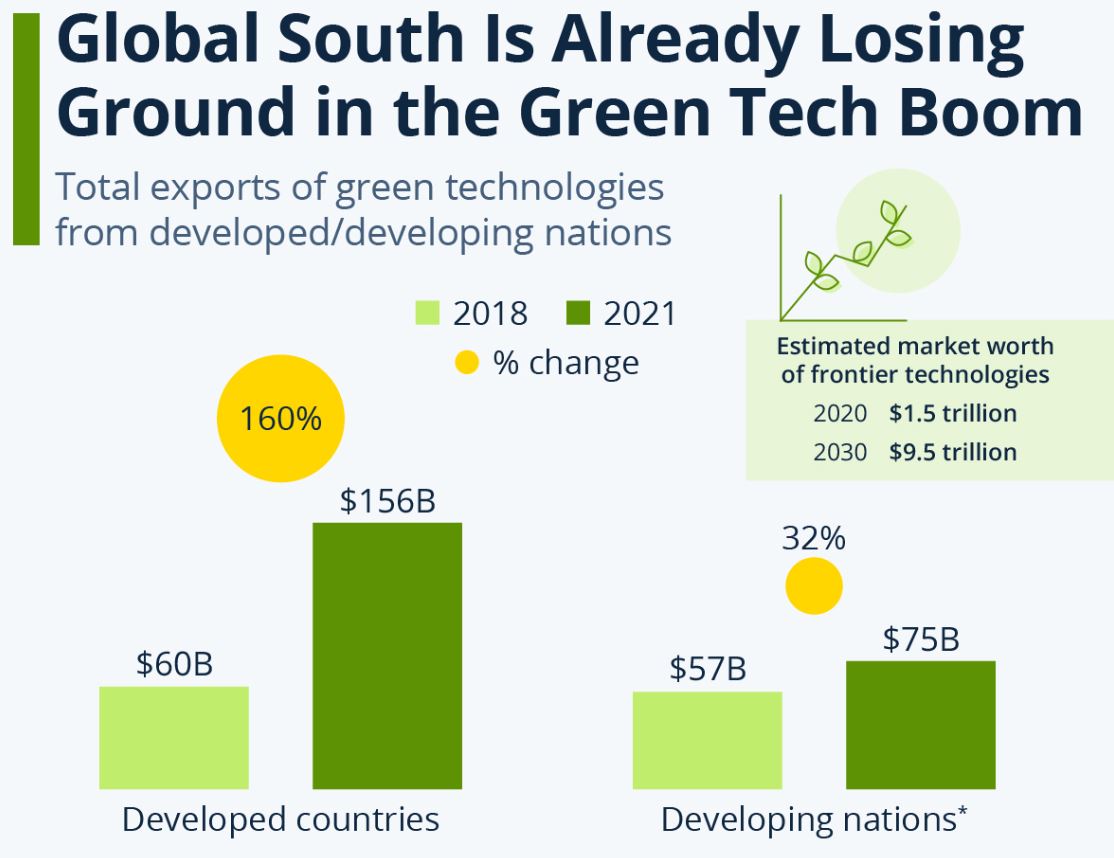
(Source: statista.com)
- According to the United Nations, many Global South countries may find themselves second in the green technology transition unless urgent action is taken by national governments as well as the international community.
- These technologies are now fast-growing and will develop into a massive industry. The global market for these technologies was worth US$1.5 trillion in 2020, with projections to reach up to US$9.5 trillion in 2030.
- Back in 2018, rich and poor countries were almost equal in how much they exported in green technologies, around US$60 billion each.
- But by 2021, developed nations had surged ahead, exporting US$156 billion worth of green technologies, while developing countries only managed US$75 billion.
- Rising disparities are shown here; the longer these persist, the greater will be the difficulty for poorer developing countries to catch up.
- Therefore, UNCTAD is pressing developing countries to undertake policy measures favouring green and high-tech industries, strengthen science and technical skill-sets, improve internet and technological infrastructure, and bridge the urban and rural divide.
- Richer nations are requested to align their trade rules with the objectives of the Paris Agreement on climate change.
Top Industry Investing In Green Tech Sector
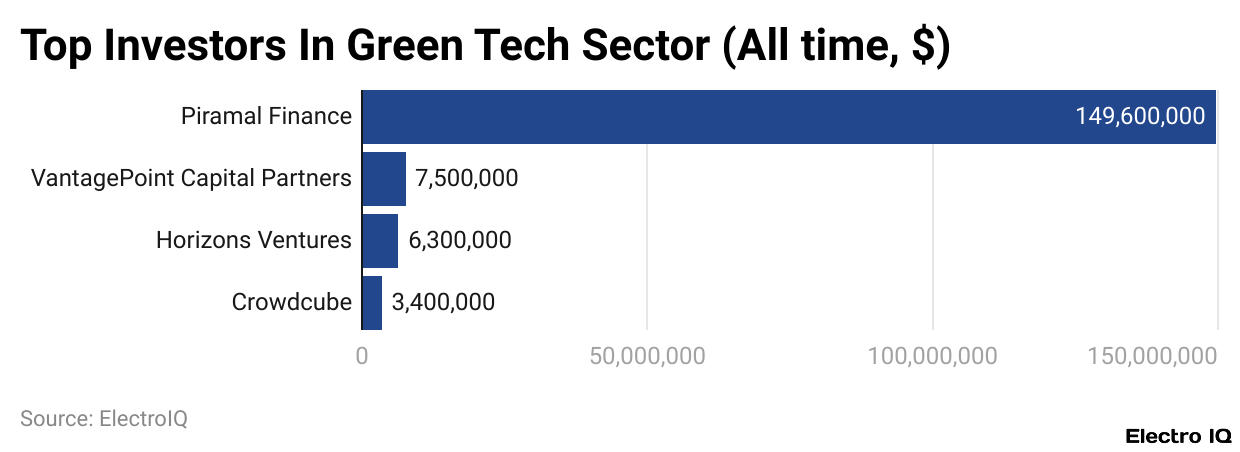
(Reference: startus-insights.com)
- Piramal Finance has undertaken investments of nearly USD 149.6 million in at least one company, demonstrating its firm backing for green technology, and has also raised a USD 100 million social loan to finance projects with social impact.
- VantagePoint Capital Partners has invested USD 7.5 million in two companies, being an early investor of Tesla Motors, indicating their interest in green tech ventures.
- Horizons Ventures has invested USD 6.3 million into two companies, thereby facilitating the development of new green technologies.
- Crowdcube has invested USD 3.4 million into three companies, adopting a somewhat diversified approach within the sector.
Green Tech Trends
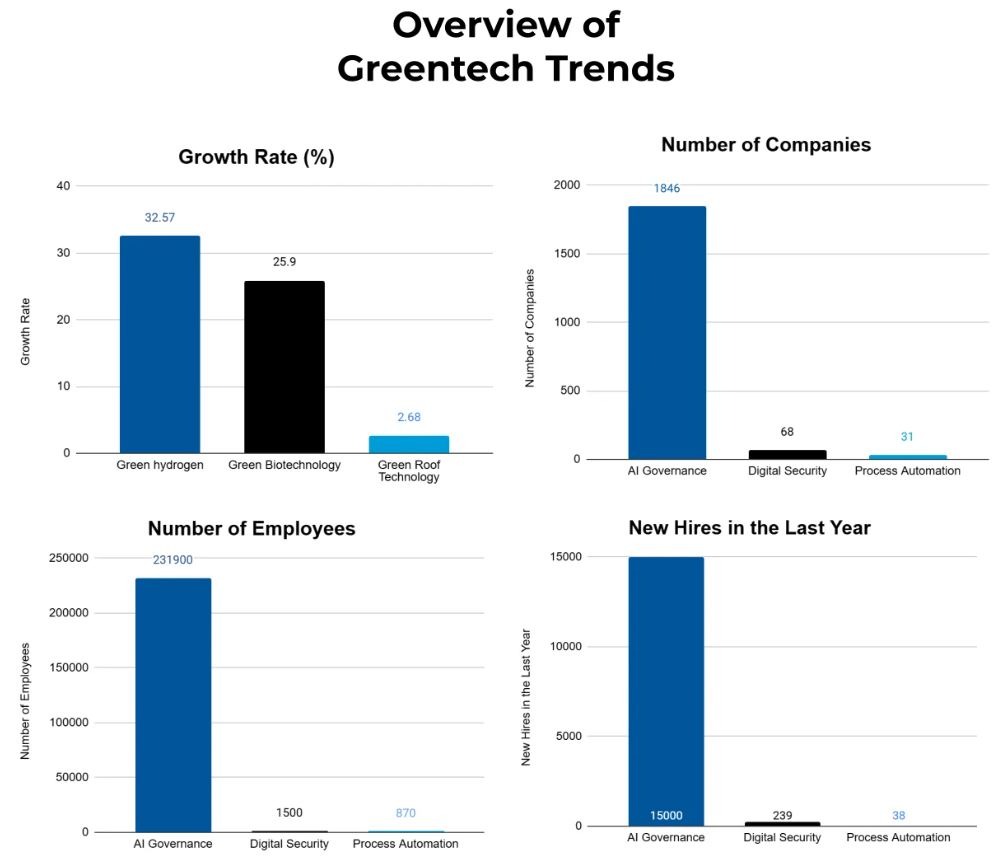
(Source: startus-insights.com)
- Being the scion of renewable energy systems, and expanding at the rate of 32.57% annually, the interest in green hydrogen is growing at a rapid pace, with some 1,846 companies and 231,900 employees, among whom 15,000 new jobs were created in the last year alone.
- Green biotechnology, smaller in size but growing, has 68 companies and 1,500 employees, of whom 239 were hired in the last year.
- This sector, which supports sustainable farming, biofuels, and environmental management, is growing at a rate of 25.9% per year.
- Green roof technology in a city conserves energy, reduces heat, and aids biodiversity; 31 companies have been created with 870 employees, with 38 new positions created also in the past year.
- It is a much slower-growing sector, with an average rate of 2.68%.
UK’s Green Technology Landscape
- Having risen to stature as a world leader in green technology, the UK lays claim to the largest start-up technology ecosystem in Europe, valued at US$1 trillion plus in 2024, and providing work for approximately 3 million people.
- With over 5,200 companies in climate tech, second only to the US in the world, contributing £71 billion per annum to the economy, whilst sustaining 840,000 jobs.
- In 2024, 14,500 new jobs were generated for a total of 244,500 jobs in the sector, with nine unicorns established so far and another nineteen companies in the prospective pipeline.
- The UK also reflects wider social progress: 17% of climate tech startups are founded by women, which corresponds to the 17% national average for businesses in general.
- It is forecast that the global green tech market is going to hit €12 trillion by 2030.
- Despite global volatilities, investment in climate tech in the UK remains stellar.
- These startups raised £4.5 billion in 2024, marking a 24% increase over the previous year.
- In 2023, venture capital investment was reported at US$6.2 billion, around 29% of all venture capital activity within the UK.
- Early-stage funding for clean tech has exploded, with major players such as Octopus Group raising in excess of £1.2 billion.
- Even though funding took a big drop globally, UK climate tech funding went down by just 4% in 2023, presenting a strong visage.
- Alongside, there has been government support, which came into the limelight, especially with the £960 million Green Industries Growth Accelerator, intended to develop clean energy supply chains.
- On the regional scene, London is the big winner, hosting 44% of the climate tech firms and investment; however, other contenders like Scotland and the East of England do well in terms of funding and generic university spinouts.
- The energy and power sector still constitutes more than half of the UK’s climate tech ecosystem and commands the maximum investments, whereas the built environment sector remains underfunded despite its very importance.
- The country also excels in innovation, with 2,700-plus green tech patents filed in 2024, complemented by a strong set of university spinouts from Oxford and Cambridge.
- The UK is truly an R&D-based powerhouse for sustainability in offshore wind, solar, and digital technologies, although gaps still exist at the scaling level of global climate goals.
- From a policy perspective, the UK boasts a 53% reduction in GHG emissions since 1990, has nearly wiped coal from the atlas, and drills down investments into billions of green funds.
- Yet, impediments remain in terms of low material circularity and tremendous mineral demand for net zero.
- Moving forward, hydrogen, AI infrastructure, and the broadening of emissions trading are under scrutiny.
- Around the globe, third in tech innovation, the UK leads Europe in climate tech funding, which is 40% of Europe’s total.
- Together, these feats put the UK at the forefront in moulding the future of green technology and sustainable growth.
Recent Developments
- According to AkzoNobel press releases in February 2025, a waterborne wood coating with 20% bio-based content was created by the AkzoNobel scientists, which was sold under the brand Sikkens Wood Coatings as RUBBOL WF 3350.
- It is sprayable and opaque and is being developed under the sustainable innovation theme to utilise more renewable raw materials while ensuring quality and durability.
- South Korea began the large-scale production of blue-green hydrogen through the multi-partner project in May 2025.
- This project makes the new generation of hydrogen by producing 3 tons of hydrogen per day from landfill gases in metropolitan areas using domestic plasma and low-temperature adsorption technologies.
- In December 2024, TKIL Industries Pvt. Ltd. took a step further into the green hydrogen space by investing in SoHHytec SA, a Swiss hydrogen technology innovator.
- This step is to support India’s target of producing 7.5 million tonnes of green hydrogen annually by 2030 to cut carbon emissions from heavy industries and transportation avenues while providing for its growing energy demand.
- Also, it was in December 2024 that the DD Scientific set upon launching its new air quality sensor range, PPB, at the Air Quality & Emission Show, held in Birmingham.
- With the sensors being marked by automated advanced production, they represent the highest standards of reliability and precision in the very low concentration detection of pollution in the environment.
- In November 2024, the Food and Agriculture Organisation (FAO) launched a three-year regime called AIM4Commodities, funded by a German Agency for International Cooperation grant of USD 1.4 million.
- The program shall improve forest-related data by tools such as the Open Foris Whisp platform that supports Indigenous communities and smallholder farmers in practising sustainable agriculture and proving compliance with regulated markets. This initiative protects livelihoods and incentivises sustainable agrifood systems.
Conclusion
Green Tech Statistics: The green technologies have been developing much in the world: considerable growth of markets, investments, and jobs in sectors such as hydrogen, biotechnology, and sustainable infrastructure. Developed countries will have primacy in the readiness, technology, and exports, while developing countries will risk facing potential famine without adequate support in policy and infrastructure. The UK has, thus, come to lead the continent as a climate tech innovator, investor, and job creator.
Moreover, recent developments encompassing a panoply of innovations with projects in hydrogen, sustainable materials, and air quality sensors have put a spotlight on the innovation potential of this sector. While challenges involving material demand and interlinked funding gaps remain, green tech essentially stands at the core of climate targets and sustainable development.
FAQ.
The global green technology market consists of over 3,100 companies and 1,611 start-ups, having shown growth in the past year at a rate of 8.90%. It is expected to reach USD 185.21 billion by 2034, at a CAGR of 22.94%.
According to UNCTAD, the United States, Sweden, Singapore, Switzerland, and the Netherlands are very prepared for the time of frontier technologies, while Guinea and South Sudan rank among the very least prepared.
Green hydrogen employs 231,900 persons across 1,846 companie,s growing at 32.57% a year. Green biotech employs some 1,500 workers across 68 companies, growing at roughly 25.9%, while green roof tech supports 870 jobs but is seeing a sluggish 2.68% growth.
The UK hosts Europe’s biggest green tech ecosystem worth over US$1 trillion, with 5,200+ climate tech firms and an annual economic contribution of £71 billion. It is a rank holder in patenting, investments, and job creation and emission reduction by 53% since 1990.
Some of the major developments include AkzoNobel’s bio-based wood coating, landfill hydrogen project in South Korea, India investing in SoHHytec for hydrogen, DD-Scientific’s state-of-the-art air quality sensors, and the AIM4Commodities initiative by FAO for sustainable agriculture and forest management.

I hold an MBA in Finance and Marketing, bringing a unique blend of business acumen and creative communication skills. With experience as a content in crafting statistical and research-backed content across multiple domains, including education, technology, product reviews, and company website analytics, I specialize in producing engaging, informative, and SEO-optimized content tailored to diverse audiences. My work bridges technical accuracy with compelling storytelling, helping brands educate, inform, and connect with their target markets.










